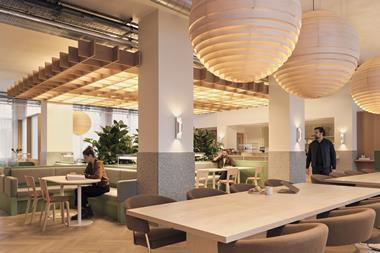As built-environment professionals, we should be championing the value of the office to our daily lives. We have spent our careers observing how offices can be effective and, if done correctly, create value by harnessing the power of good design.

We ought to have a loud voice about why workplaces are important for our mental health, our productivity and our lifestyles. This vocal approach can be taken in an open-minded way that remains cognisant of what we have learned during this period of working from home (WFH) — staying calm, collected and thoughtful, while others are making knee-jerk assumptions that feed the “death of the office” narrative.
We must appreciate the office and not become complacent about the important role it plays in our lives. It is foremost an equitable place: everyone has a similar amount of space, their own seat to sit on, similar facilities and technology. Not least, everyone has a space where heating and electricity are paid for, something which will become more important over the coming months.
We have been hearing a lot about how effective WFH is — and it has been. WFH has surprised many people by how quickly we all have mobilised and how far we can get with remote working. The people we often hear promoting WFH are those with comfortable surroundings and a clearly defined home office. I have read fewer accounts in the press and social media from people who have struggled with WFH — those working in cramped conditions, sharing a kitchen table or within earshot of flatmates and children.
The office also provides a place where you can learn from others – not by staring at a screen but by working with them and observing how they operate.
Informal working
My own professional development has tended to come from informal working alongside colleagues and clients, rather than formal training sessions. I have observed how real creative leadership and senior people operate, how they direct and build businesses.
Equally, I have learned from the energy and fresh perspectives of graduates. The creative, collaborative office is the catalyst for this kind of professional development, where experience is absorbed and passed down by osmosis. Would this still happen to the same extent if your home was the primary place of work and the office was just a place to ‘drop into’ for meetings? I think not.

The culture of an office is a collective zeitgeist, a professional team-based environment and a place for social interaction. This vision for a successful office shares many of the qualities of a university campus, and to ignore this kinetic quality could lead to serious, irreparable damage to a business’s culture.
We have been having regular practice-wide updates over the past five months, and Microsoft Teams has been great in communicating to our three offices regularly. While the technology allows us to spread news in a new and more efficient way, there is a big difference between imparting information and collaboration — with the latter fuelled by more discursive thinking that the modern office not only caters for but actively encourages.
Chance encounters
No matter what industry we design for, clients always value how chance encounters spark ideas. Businesses have been trying to encourage these for the past decade, with activity in the blurred edges between disciplines and teams the goal for many organisations. The workday built around a schedule of video calls does not have the same dynamic, and if we do not acknowledge the power of constructive collisions in our workplace cultures, it is creativity that will suffer.
In a way, the merging of home and office is nothing new. This idea of convergence has been happening for some time, with agility, flexibility and choice high on the workplace agenda for the past decade. Our clients are looking to us to remain open-minded and balanced. Instead of making sweeping, headline-grabbing forecasts, we should be slowing down the pace of debate to really think about how the future office and WFH complement each other to boost wellness, productivity and efficiency.
Helen Berresford is head of ID:SR Sheppard Robson






























No comments yet